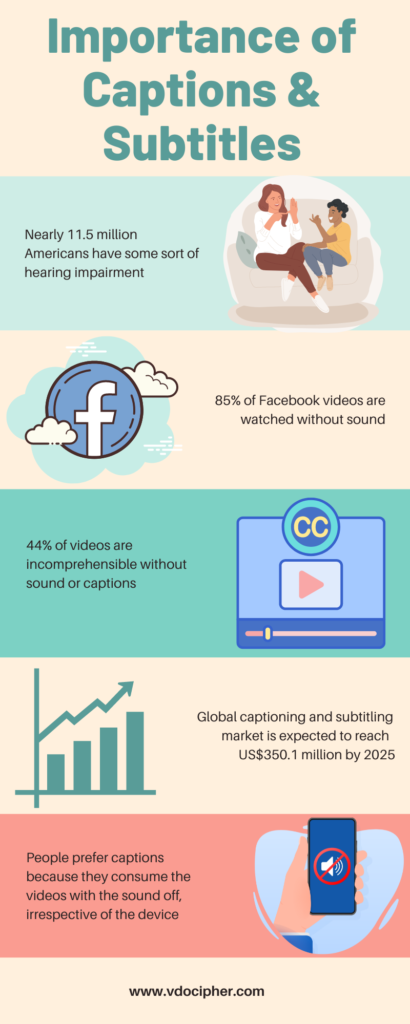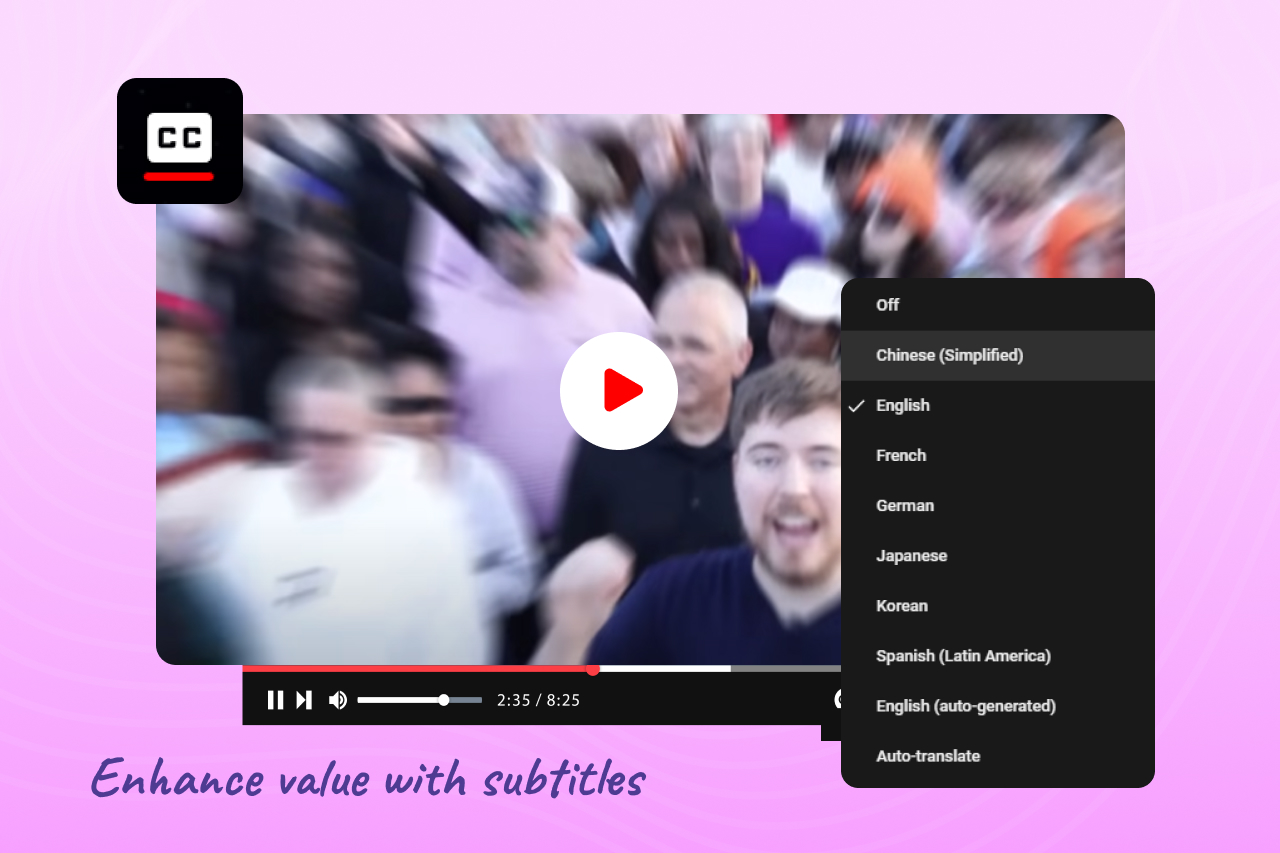Did you know that audio-visual content holds a popular medium for delivering information and education? But more than 57% of students prefer in-person teaching over virtual mode.
Do you wonder why? A recent survey performed in top universities in the USA claims that 3 out of 4 students are not happy with e-learning systems as it lacks modern accessibility options like captions.
In fact, students or viewers with hearing impairment, language barriers, or who live in noisy environments find it difficult to watch videos for the same reason. Here, subtitles/captions provide an effective solution to boost engagement and drive new views.
Unfortunately, many creators still don’t understand the importance of subtitles and captions because their concept is not clear yet. Captions and subtitles both display text on the screen to convey spoken dialogue. Captions represent the spoken language, while subtitles can be translated into multilingual videos.
As 99% of students find captions and subtitles helpful for fast learning, content creators can leverage it to dissolve accessibility challenges and enhance the educational value of their videos.

Hence, we are going to explore how subtitles can enhance the educational value of your multilingual content. Continue reading!
The Power Of Captions & Subtitles In Enhancing Accessibility
Ever since the pandemic outbreaks across the world virtual learning systems have become widespread. But, in reality, only a few are able to cope with the system and feel positive. Over 68% of students expect more technology inclusion to understand the module in depth.
So, where’s the lock? It is that the majority of students face one problem when their educators are not front i.e. understanding the commands.
However, video content creators can effortlessly solve this problem by adding captions manually or using a subtitle generator. The rationale behind this solution is:
- When students have access to high-quality captions, they comprehend and retain information effectively, leading to a more successful learning experience.
- Multilingual subtitles connect educators with more students regardless of their language and make a lasting impact on their education.
- Using subtitles, creators can expand the reach of multilingual videos to a wider audience, including individuals who are non-native speakers of the language used in the video.
Master The Art Of Improving Comprehension

Do you know only 20% of people speak English worldwide? Moreover, a study reveals that 68% of consumers love to communicate in their native language, which is why audiences are more likely to watch content published in their preferred language or have subtitles in their native language than those in foreign languages. Hence, subtitles or captions play a pivotal role in improving conversations.
Moreover, for people who are willing to learn a second language, captioned multilingual videos simplifies their learning process. If a person has better reading skills than speaking/listening, subtitles reinforce comprehension.
Still wondering how? Let’s explore some real case studies.
A study performed at Oregon University claims that 52% of students found captioned videos helpful as they improve their comprehension. In fact, the senior manager at Oracle agrees with the benefit of the same for training purposes. In a corporate setting when two employees are from two different geographic cultures, their accents will vary. Here, captions help to comprehend the transcripts and add educational value.
Hear, Read & Learn Through Subtitles
Till now we have understood that video content with captions/subtitles offer multifaceted benefits like better comprehension and enhanced accessibility. There are some other benefits as well like impact on cognitive functions & enhanced retention for audiences and students.
Impact of subtitles on cognitive load
Subtitles and captions make educational content more accessible, especially for those with hearing impairments or those watching content in a foreign language. Subtitles enable viewers to read text that reduces cognitive load and enhances the learning experience.
- Combining the use of audio and visual text helps in solidifying and reinforcing cognitive functions. In fact, captions strengthen the reading ability in children by 2X.
- As the human brain has limited working memory, captions help aid the information processing for audiences with disabilities when their brain is overwhelmed.

Relationship between subtitles and retention
A recent US Department of Labor study claims that using audio-visual learning frameworks aids in 65% of retention in just three days. Nonetheless, the retention rate can significantly drop to 10% using only auditory aids.
When creators use native language transcriptions or captions in their videos, the audiences feel more valued and heard. 3 out of 4 students can feel enhanced accessibility and inclusiveness as captions enable learners to understand modules at their own pace. This appreciates and retains them for a long time.
Well, research claims out of all the videos published on video-sharing platforms, 85% are viewed without sound, making it crucial to incorporate captions. Furthermore, statistics show that 91% of viewers are more likely to watch captioned videos to completion compared to slightly over 60% for videos without captions. So, it proves that subtitles are crucial to retain users and encourage interactions.
Subtitles As Real Game-changer For Facilitating Multilingual Education
Subtitles are not just about accessibility; they can also enhance learning in multiple languages. Moreover, educational materials with subtitles in diverse languages can eliminate language barriers, promote cross-cultural understanding, and facilitate cooperation. So, consider adding subtitles in multiple languages to your videos to enhance the educational value and promote diversity and inclusion.
For example, the top public research institutions, the Chinese University in Hong Kong, the Hetet School of Maori Art, and Algonquin College in Canada, used translated subtitles provided by a third-party subtitles generator to make their learning accessible for all. Globally, multilingual education is becoming popular and some languages like Chinese, Spanish, Arabic, and Portuguese have gained attention with the popularity of captioned videos. Over 170 internet users prefer Arabic language content and it currently holds the position of the top-10 growing languages.
Role of Dual Coding To Improve Language Learning

As proposed by Allan Pavio in 1971, Dual coding is a powerful cognitive process that involves combining visual and verbal stimuli to enhance learning and memory. By utilizing a combination of various sensory inputs, the process aids learners in encoding information more efficiently, ultimately resulting in improved retrieval at a later stage. Subtitles act the same for video content because it stimulates both auditory and visual aspects of human brains that lead to an enhanced learning process.
In an educational setting, the primary forms of stimuli utilized are visual and verbal, and here subtitles can work best to improve language learning in three ways–
- When anybody watches international movies or series, the subtitles help to build their vocabulary.
- It helps audiences to recognize new phrases every time.
- The perfect synchronization of visual and auditory stimuli catalyzes the learning process.
Subtitles Boost SEO To Maximize Reach
Do you know by leveraging the power of subtitles and dual coding content creators can improve subtitles the SEO ranking? Indeed. No wonder better SEO optimization will help to reach their video to more audiences. But how? Let’s check some facts.
- There is no debate that when you input captions in multilingual content, it attracts more views. Because Google Search Engine acts in a way that indexes manually added captions instead of automated ones and enhances your keyword depth.
- When you add closed captions in content, it gets easily readable by Google. This in turn helps in technical optimizations.
- Subtitles make your video more engaging. Hence, it attracts more backlinks.

How to Add Subtitles to Your Educational Videos?
We have shortlisted some popular tools and formats to generate subtitles listed below.
● SRT or SubRip: An universal format that uses sequence number, text, and time code to customize subtitles.
● TTML or Timed Text Markup Language: It is mostly used in live video streaming, television streaming and VOD domains.
● WebVTT: The web video text tracks are the most convenient ones used to add subtitles on HTML5 pages.
If you wish to scale up your content creation, use online subtitle generator tools like Dubverse. The AI-powered platform automatically streamlines your content and generates subtitles with the help of advanced technology and algorithms.
A step-by-step guide to generating subtitles for your videos using Dubverse
To add subtitles using Dubverse, follow these simple steps –
● Go to the Dubverse web app. Click the ‘SUB’ button to open the subtitles box in your chosen language
● Upload the video.
● Click on the ‘Let’s SUB’ button, and your subtitles will be ready in an SRT format.
Tips For Creating Accurate & Effective Subtitles
Now that you know the importance of subtitles to add value to video content, you must know some golden rules for effective subtitling.
- When it reaches over 42 characters, break it into two sentences for easy understanding.
- Keep your subtitle short, within two lines.
- Set the subtitling speed at 21 characters per second.
- Do not exaggerate the meaning, and preserve it as much as possible.
The Final Verdict
Adding subtitles to educational videos significantly enhance comprehension and retention levels and impact learning outcomes across different age groups positively.
As content creators, the power is in your hands to maximize the educational value of your videos by incorporating multilingual subtitles to cater to wider audience without letting language barriers hinder the learning process.


